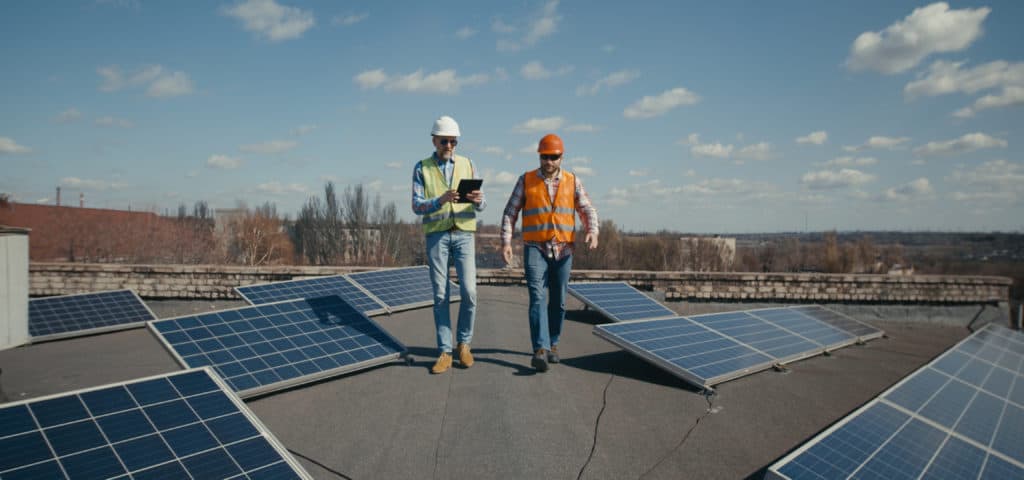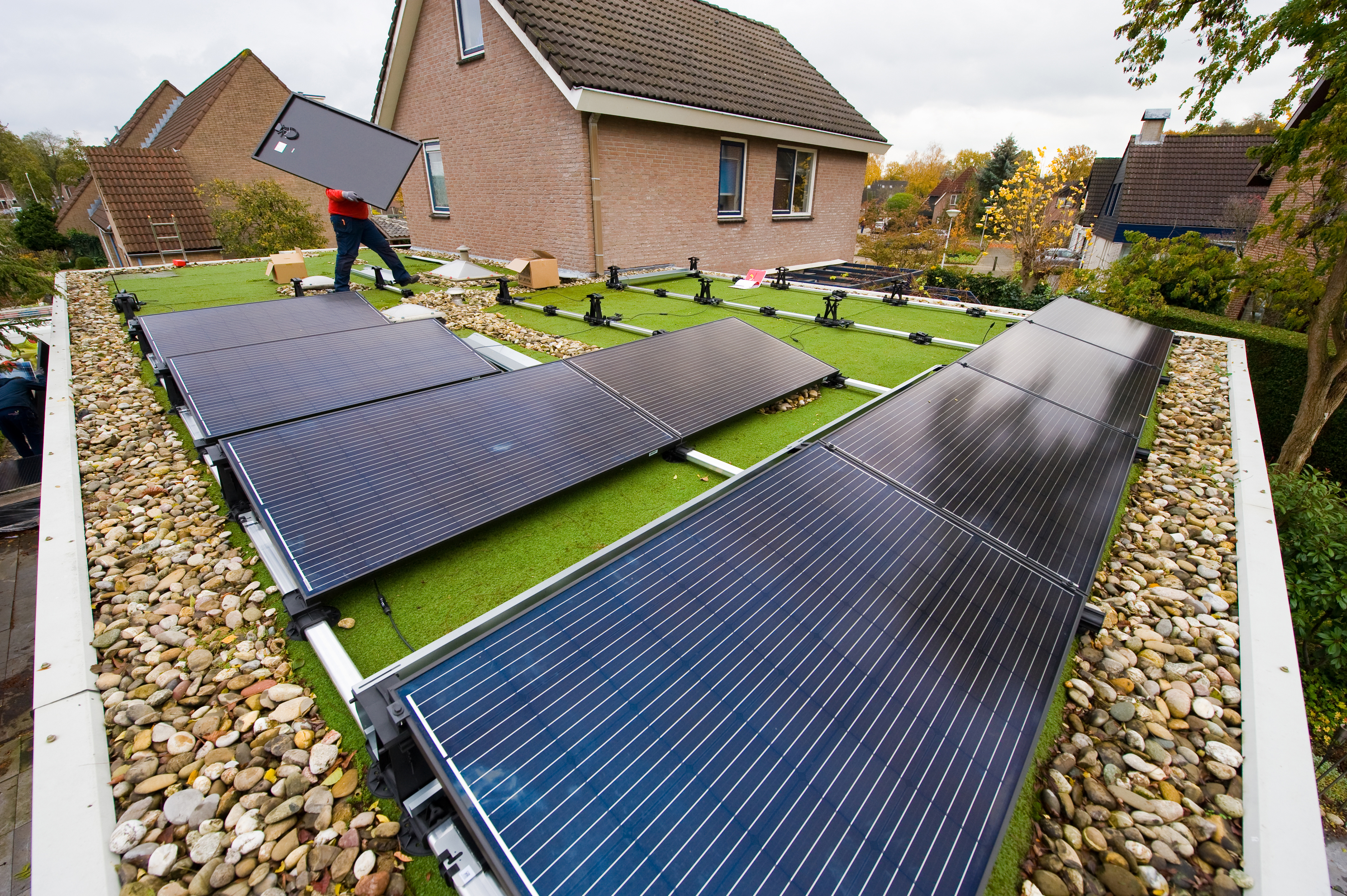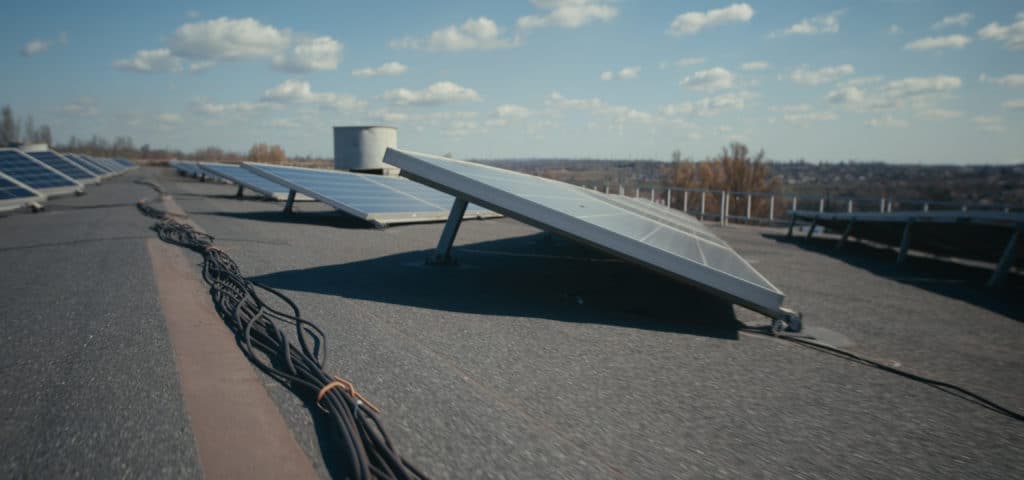
Home solar units are growing more and more popular by the year. The technology is becoming increasingly advanced, and solar panels can be installed just about anywhere, from the desert to your house, even if you have a flat roof.
Solar panels can be installed onto flat roofs. It is often easier to install solar panels onto flat roofs because of the lack of a slope, however, the panels will need to be angled to receive full sun exposure, which could increase the cost of installation.
How does flat roof solar installation work? Is it better to install solar panels onto slopped roofs or flat roofs?
Flat Roof Solar Installation
Not only is it possible to install solar panels on a flat roof, it can be better than installing them on a sloped roof. There are many benefits to flat roof installation. It makes it much easier for the workers to install solar panels onto a flat roof because the lack of a slope makes for sure footing. It is a lot harder to fall or slip when you are standing on flat, sturdy ground! Especially when carrying heavy solar panels, sure footing can make installation go by much more smoothly.
Solar panels weigh on average 40 pounds. That is only the panel, not the entire array! So, getting these heavy units onto your roof and installed can be quite the process. Luckily, with flat roofs, the troubles are over once your get the panel onto the roof. You can just set it down! It does not have to be held in place at an angle while it is being installed like it would on a sloped roof. How nice! The workers also do not need any kind of harness system or special safety equipment to make sure they do not fall off the roof during installation.

Because solar panels are easier to install onto flat roofs, the cost of installation is typically cheaper than installation on a sloped roof. However, you will need to tilt your solar panels so that they are at an angle, and that can add to the cost of your installation.
Another benefit to installing solar panels onto a flat roof is that you can use a ballast system instead of a penetration system. Penetration mounts work by drilling holes into your roof to attach the racking system whereas a ballast system uses gravity to keep your solar panels in place. Mounts/racking systems are what keep your solar panels in place on top of your roof.
- Penetration Mounts: These mounts are commonly used on sloped roofs. Holes are drilled into the roof’s structures to secure the mount into place. To find the structures, you need to use a stud finder that will indicate where the best places to drill holes are. These holes then need to be waterproofed to prevent any leaking.
- Ballast Mounts: These mounts work best on slightly sloped or flat roofs. Ballast mounts allow you to avoid the hassle of drilling holes into your roof. They work by using a free-standing base that sits on top of your roof and is held in place by concrete blocks (or something similar). This type of mount relies on its heavy weight to stay in place. It is typically the more cost-efficient option and requires minimal hardware to assemble.
While both types of mounts have benefits and drawbacks, ballast mounts are typically the preferred option. They are easier to install because you will not need to waste time and energy finding support structures and drilling holes into your roof. You also will not need to then seal those holes back up to prevent future water damage. However, when using a ballast system, you will need to make sure that your roof can withstand the heavy structure. This system relies on gravity and the weight of your solar panels, so if your roof is not able to hold all of that weight, then you should consider other mounting options.
You also need to make sure that your panels will not be carried away in case of a wind storm. If you live in an incredibly windy location, you might consider using an attached type of mounting system so your panels do not end up blown down the street. You can also use a hybrid system that uses both types of mounting to install your solar panels if you are worried about them staying in place.
When planning the installation of your solar panels, you should consider the units already on top of your roof:
- Outdoor Air Conditioning Units.
- Drains.
- Exhaust fans.
- Vents.
- Water tanks.
- Parapets.
- Rooftop structures.
- AC and water pipes.
- etc.
-Source

It is important to make sure that you not only have enough space for your solar panels but that they will not be blocked or shaded by any existing rooftop units. The more sunlight is blocked, the less energy your solar panels will produce.
You also will need to consider the risk of water pooling on your roof. Sloped roofs do not typically need to worry about any water pooling since the water runs down and off of the roof. However, flat roofs retain water since it has nowhere to go. Installing solar panels onto your flat roof can increase risk of water leakage and damage if you go for an attachment method since this method requires that you drill holes into your roof. Be sure that each hole is sealed up extremely well to prevent future damage to your roof.
If you have a flat garage roof, you can also consider installing solar panels there as well. This helps to utilize space and installation will not disrupt your home life.
If you are trying to find professionals to install your solar panels, you might need to try a little harder than you would if you had a sloped roof. Not every solar installation company has the equipment and experience to install panels onto a flat roof, especially if flat roofs are uncommon in your area. If you run into this problem, just keep looking! There are plenty of different solar companies that would be happy to accommodate your needs.
You can also install solar panels onto your roof yourself if you have all of the right equipment and instructions. It is much easier to install solar panels yourself if you have a flat roof, especially if you decide to use a ballast system that does not require any kind of drilling and hole sealing. However, it is always recommended to hire or consult professionals so that everything is done properly and safely.
Tilting Your Solar Panels
Another great benefit to installing solar panels onto a flat roof is that you get to decide the angle of your panels. Solar panels need to have certain angles in order to maximize daily sunlight exposure. Your panels should face south and should be tilted at about a 30-40 degree angle. You can find the optimum tilt based on your location.
There is a simple rule of thumb for calculating the best tilt angle for fixed-mount solar panels. Subtract 15 degrees from the latitude at your location during summer and add 15 degrees to your latitude during winter.
Source
While most solar panel mounts are permanent, you can also purchase adjustable legs that allow you to change the tilt of your panels from season to season. While you might want to try this to get as much energy as possible, it is a lot of work and will not make much of a difference, therefore it is not recommended.

There are other benefits to having tilted panels. Solar panels that are installed at an angle will be cleaned after every rainfall. Rain runs down the glass on the panel and will wash away dust and small debris such as bird poop or leaves. If your solar panel is flat to your flat roof (without any angle), then the rain will have a harder time washing your panels clean. Instead, the water will just pool and the dust will not rinse off.
If you do not tilt your solar panels:
- Dust will accumulate easily on top of your solar panels.
- Dust and other debris that accumulate will make you lose up to 10 percent of energy production.
- Cleaning your solar panels will be more challenging.
- Solar energy production will become less compared to inclined solar panels.
- Your return on investment period will be much longer.
- You may not get the full benefits of natural solar panel cleaning from the rain.
-Source
If you install solar panels onto a flat roof, you should not keep your solar panels flat as well. Tilting your panels will make the installation worthwhile. If you are completely against tilting your solar panels, then you might want to reconsider installing them onto your flat roof. Other options you have might be to install ground solar panels or pole solar panels. Both of these options will still need to be tilted to face the sun for the best results.